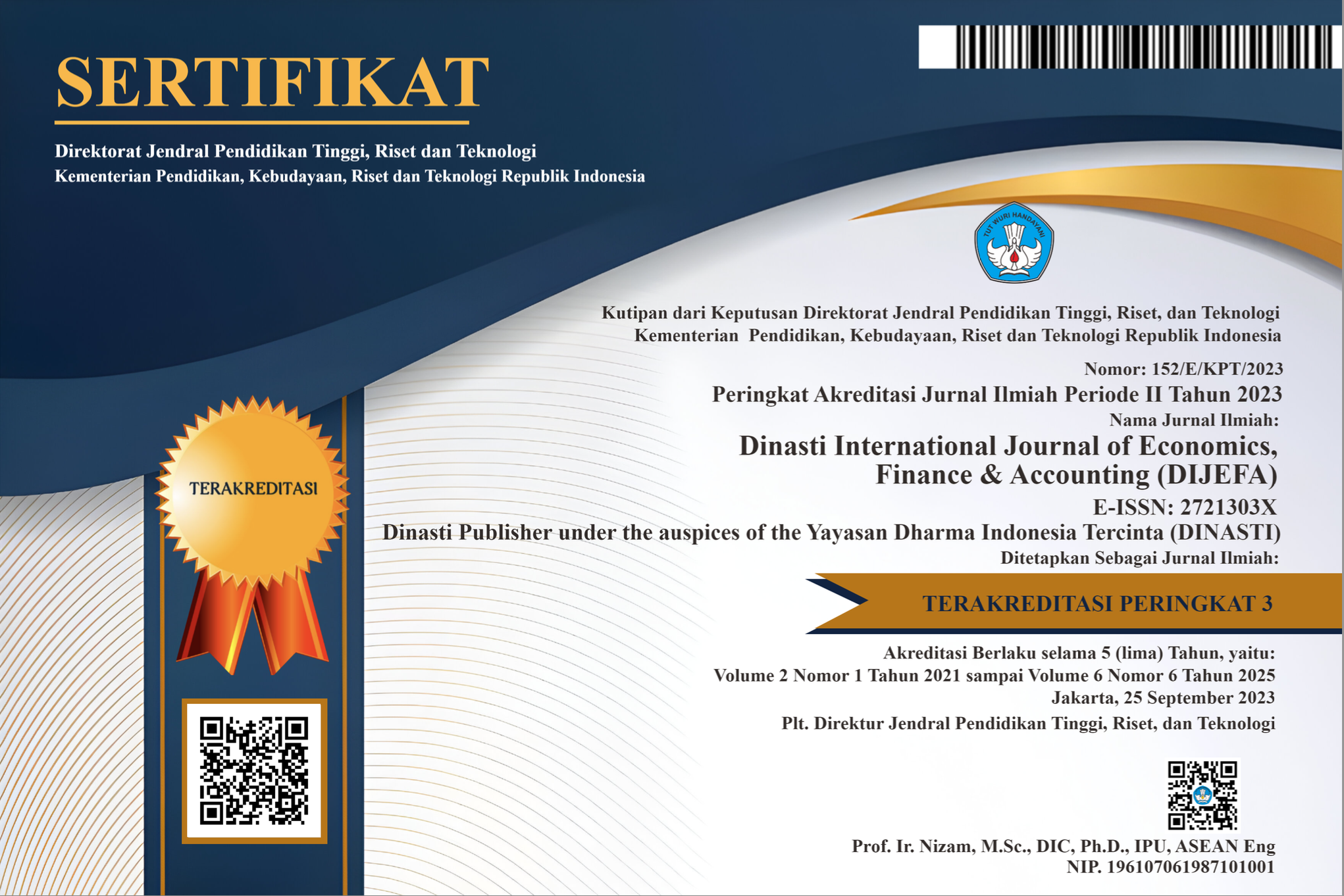Government Spending and Indonesia's Multidimensional Poverty 2018-2020
DOI:
https://doi.org/10.38035/dijefa.v5i4.3078Keywords:
Multidimensional Poverty, Government Expenditure, Housing Public Facilities Function, Social AssistanceAbstract
This research aims to analyze the effect of government spending on multidimensional poverty in Indonesia in 2018-2020. The government expenditure used is government expenditure for housing functions, public facilities and social assistance expenditure. This research uses a quantitative approach and Tobit panel regression techniques as well as secondary data for 2018-2020. The research results show that government spending, both government spending for public facilities housing functions and social assistance spending, has a positive and significant effect on multidimensional poverty in Indonesia. This research recommends to the Government that in making expenditure policies it is necessary to examine more broadly the impact on multidimensional poverty. Furthermore, the Government needs to evaluate and review the effectiveness of policies that have been implemented to reduce poverty, especially multidimensional poverty, which can be done through budget decomposition based on programs, so that the effect of spending on poverty can be seen in more detail.
References
Alkire, S., Roche, J. M., Ballon, P., Foster, J., Santos, M. E., & Seth, S. (2015). Multidimensional Poverty Measurement and Analysis. Oxford University Press, USA.
Amemiya, T. (1984). Tobit Models: A Survey. Journal of Econometrics, 24(1–2), 3–61. https://doi.org/10.1016/0304-4076(84)90074-5
Arsyad, L. (1992). Ekonomi Pembangunan. In Yogyakarta: Bagian Penerbitan Sekolah Tinggi Ilmu Ekonomi: YKPN. Bagian Penerbitan Sekolah Tinggi Ilmu Ekonomi: YKPN.
Azwardi, A. (2014). Pengaruh Pengeluaran Pemerintah Provinsi di Indonesia untuk Fungsi Ekonomi, Kesehatan, Pendidikan serta Perumahan dan Fasilitas Umum Terhadap Penduduk Miskin Tahun 2011-2013. Jurnal Ekonomi Pembangunan, 12(1), 1–11. https://doi.org/10.29259/jep.v12i1.4862
Budiantoro, S., Fanggidae, V., Saputra, W., Maftuchan, A., & Artha, D. R. P. (2013). Multidimensional Poverty Index (MPI): Konsep dan Pengukurannya di Indonesia. Perkumpulan Prakarsa.
Era Baru dalam Pengentasan Kemiskinan di Indonesia. (2007). The World Bank Office Jakarta.
Fuady, M. R. F., Fuady, M., & Aulia, F. (2021). Kemiskinan Multi Dimensi dan Indeks Pembangunan Manusia di Indonesia. TATALOKA, 23(4), 575–582.
Honore, B. E. (1992). Trimmed Lad and Least Squares Estimation of Truncated and Censored Regression Models with Fixed Effects. Econometrica, 60(3), 533. https://doi.org/10.2307/2951583
Indonesia Public Expenditure Review: Spending for Better Results. (2020). The World Bank.
Kalwij, A. S. (2004). A Two-Step First Difference Estimator for a Panel Data Tobit Model Under Conditional Mean Independence Assumptions. AIAS, Amsterdam Institute for Advances Labour Studies. https://doi.org/10.2139/ssrn.603322
Kasim, R., Engka, D. S. M., & Siwu, H. Dj. (2021). Analisis Pengaruh Inflasi, Pengangguran dan Belanja Pemerintah terhadap Kemiskinan di Kota Manado. Jurnal EMBA?: Jurnal Riset Ekonomi, Manajemen, Bisnis Dan Akuntansi, 9(1), 953–963. https://doi.org/10.35794/EMBA.V9I1.32645
Maddala, G. S. (1987). Limited Dependent Variable Models Using Panel Data. Journal of Human Resources, 307–338.
Murdiyana, M., & Mulyana, M. (2017). Analisis Kebijakan Pengentasan Kemiskinan di Indonesia. Jurnal Politik Pemerintahan Dharma Praja, 73–96.
Nurmandi, A., Lutfi, M., Sumardi, S., & Qodir, Z. (2021). Kualitas Pelayanan Publik Melalui Pendekatan Model Demokrasi pada Era Otonomi Daerah. Journal of Government Insight, 1(1), 49–61. https://doi.org/10.47030/jgi.v1i1.253
Putri, N., Yeniwati, Y., & Irfan, M. (2023). Pengaruh Bantuan Sosial dan Zakat terhadap Kemiskinan di Sumatera Barat. Ecosains: Jurnal Ilmiah Ekonomi Dan Pembangunan, 12(2), 110–117.
Rachmaningsih, T., & Priyarsono, D. S. (2012). Ketahanan Pangan di Kawasan Timur Indonesia. Jurnal Ekonomi Dan Pembangunan Indonesia, 13(1), 1.
Rosales, V. Q., Leverone, M. B., Vargas, M. S., & Murillo, C. M. (2020). Multidimensional Poverty Index and its relationship with Ecuadorian public spending. Universidad y Sociedad, 12(2), 430–436.
Sasana, H., & Kusuma, P. (2018). Government Expenditure and Poverty in Indonesia. KnE Social Sciences, 142–153.
Séne, L., & Cissé, M. (2014). Local Government Spending and Multidimensional Poverty in Senegal: Insight from The Fuzzy Approach.
Sunan, M., Husen, A., & Badar, M. A. (2022). Analisis Dampak Program Bantuan Sosial (Bansos) terhadap Kemiskinan di Kabupaten Taliabu Tahun 2015-2021. POROS EKONOMI, 1(1), 13–33. https://ejournal.unkhair.ac.id/index.php/porosekonomi/article/view/5267
Todaro, M. P., Munandar, H., & Sumiharti, Y. (2000). Pembangunan Ekonomi di Dunia Ketiga. Erlangga.
Wendha, D. N., & Alteza, M. (2020). Analisis Efisiensi Perbankan Hasil Merger di Indonesia dengan Metode Two-Stage Data Envelopment Analysis. Jurnal Ilmu Manajemen, 17(2), 85–97. https://doi.org/10.21831/JIM.V17I2.34778
Wulandari, S., Dasopang, A. P., Rawani, G. A., Hasfizetty, I., Sofian, M. Y., Dwijaya, R., & Rachmalija, S. (2022). Kebijakan Anti Kemiskinan Program Pemerintah dalam Penananggulangan Kemiskinan di Indonesia. Jurnal Inovasi Penelitian, 2(10), 3209–3218.
Yunus, R., & Anwar, A. I. (2021). Ekonomi Publik. Penerbit NEM.
Downloads
Published
How to Cite
Issue
Section
License
Copyright (c) 2024 Azzahra Alifa Ramadhani, Endrizal Ridwan

This work is licensed under a Creative Commons Attribution 4.0 International License.
Authors who publish their manuscripts in this journal agree to the following conditions:
- The copyright on each article belongs to the author(s).
- The author acknowledges that the Dinasti International Journal of Economics, Finance & Accounting (DIJEFA) has the right to be the first to publish with a Creative Commons Attribution 4.0 International license (Attribution 4.0 International (CC BY 4.0).
- Authors can submit articles separately, arrange for the non-exclusive distribution of manuscripts that have been published in this journal into other versions (e.g., sent to the author's institutional repository, publication into books, etc.), by acknowledging that the manuscript has been published for the first time in the Dinasti International Journal of Economics, Finance & Accounting (DIJEFA).


























































